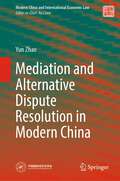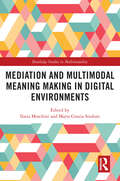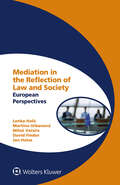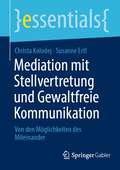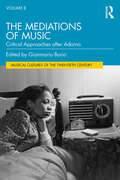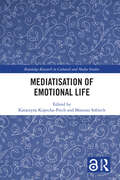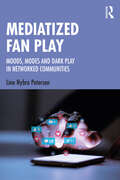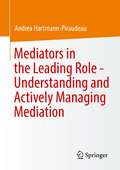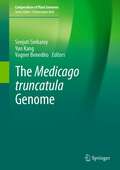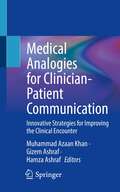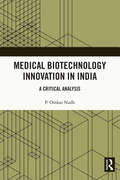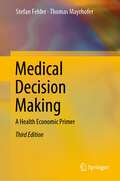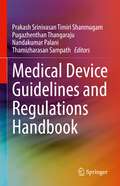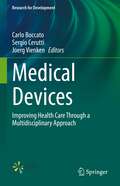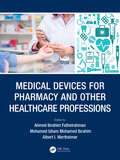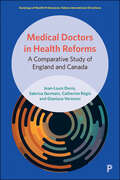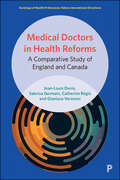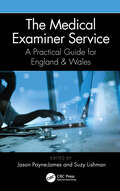- Table View
- List View
Mediation and Alternative Dispute Resolution in Modern China (Modern China and International Economic Law)
by Yun ZhaoThe book examines the development and application of mediation in China (including Hong Kong). As a popular mechanism for dispute resolution in Chinese history, mediation is believed to be an important process for realizing the official goal of social harmony. Following an overview of the current situation in mainland China and Hong Kong, the book looks into specific legal issues in the application of mediation and the practical use of mediation in specific lines of businesses. The book can serve as an important reference book on the law and practice of mediation in mainland China and Hong Kong for scholars, practitioners, as well as students of mediation and alternative dispute resolution.
Mediation and Multimodal Meaning Making in Digital Environments (Routledge Studies in Multimodality)
by Maria Grazia Sindoni Ilaria MoschiniThis collection explores the mediation of a wide range of processes, texts, and practices in contemporary digital environments through the lens of a multimodal theory of communication. Bringing together contributions from renowned scholars in the field, the book builds on the notion that any form of digital communication inherently presents a rich combination of different semiotic modes and resources as a jumping-off point from which to critically reflect on digital mediation from three different perspectives. The first section looks at social and semiotic practices and the implications of their mediation on artistic production, cultural heritage, and commerce. The second part of the volume focuses on dynamics of awareness, cognition, and identity formation in participants to digitally-mediated communicative processes. The book’s final section considers the impact of mediation on shaping new and different types of textualities and genres in digital spaces. The book will be of particular interest to scholars, researchers and students in multimodality, digital communication, social semiotics, and media studies.
Mediation and Multimodal Meaning Making in Digital Environments (Routledge Studies in Multimodality)
by Ilaria Moschini and Maria Grazia SindoniThis collection explores the mediation of a wide range of processes, texts, and practices in contemporary digital environments through the lens of a multimodal theory of communication. Bringing together contributions from renowned scholars in the field, the book builds on the notion that any form of digital communication inherently presents a rich combination of different semiotic modes and resources as a jumping-off point from which to critically reflect on digital mediation from three different perspectives. The first section looks at social and semiotic practices and the implications of their mediation on artistic production, cultural heritage, and commerce. The second part of the volume focuses on dynamics of awareness, cognition, and identity formation in participants to digitally-mediated communicative processes. The book’s final section considers the impact of mediation on shaping new and different types of textualities and genres in digital spaces. The book will be of particular interest to scholars, researchers and students in multimodality, digital communication, social semiotics, and media studies.
Mediation in the Reflection of Law and Society: European Perspectives (Global Trends in Dispute Resolution Series)
by Lenka Holá Miloš Večeřa Martina Urbanová Jan Holas David FiedorDespite slow progress in use, mediation continues to consolidate its presence in dispute resolution. This important book argues that a more favourable socio-legal climate must be created for mediation to thrive, and accordingly analyses the legal, cultural, social, systemic and spatial aspects of the use of mediation in the legal practice of the different countries of the European Union (EU). Based on a spatiotemporal analysis and models of mediation in the EU, it pinpoints the social and cultural reasons for the fragmentation of its legal regulation and shows what paths are available to promote the effective implementation of mediation in social practice. It is the first book to capture the socio-legal context of mediation. A spatiotemporal analysis of the extent of use of mediation in a region as large and at the same time as diverse as the EU has never been carried out before. Using various methodological and conceptual approaches to analyse the legal and social aspects of introducing mediation to legal systems, the authors – all with long-term experience in the exercise and research of mediation directly in the field – provide invaluable insights into such facets of the use of mediation as the following: the social context that raises the need for mediation; obstacles to the wider use of mediation in resolving disputes between parties; the effects of social influences reflected in legislation that shape the laws of each country; the basic models that make up the system of access to mediation in specific EU Member States; the role of law as a tool for social change and its reflection in the legal regulation of mediation; and perspectives for further development of mediation in the EU. The legislative efforts proposed to enhance the regulation of mediation in EU countries are based on modern knowledge of law, sociology and psychology. As a unique combination of exploration of the theoretical determinants of mediation and an empirical study of the extent of its use in the European area, this book’s fundamental contribution to the legal theory and practice of mediation is inarguable. Its analysis of mediation from three perspectives – as a means of improving citizens’ access to justice, as a means of applying social justice in society, and as a means of restorative justice – are of the utmost value in today’s global society. For users of mediation, EU institutions involved in mediation, EU Member State authorities addressing the issue of mediation, and the wider dispute resolution community worldwide, the book will be welcomed for the giant steps it takes toward refining arguments for the promotion of mediation and its development, in theory, research and practice.
Mediation mit Stellvertretung und Gewaltfreie Kommunikation: Von den Möglichkeiten des Miteinander (essentials)
by Christa Kolodej Susanne ErtlDas Konzept der Mediation mit Stellvertretung wird mittels theoretischer Inputs, praktischer Übungen und Fallbeispielen vorgestellt. Oft wünschen sich Konfliktbeteiligte eine direkte gemeinsame Konfliktregelung, das ist aber nicht immer möglich. Die stellvertretende Rollenübernahme der abwesenden Partei durch eine/einen Mediator*in mittels der repräsentierenden Wahrnehmung eröffnet hier neue Möglichkeiten, die weit über das Feld der Mediation hinausgehen.
The Mediations of Music: Critical Approaches after Adorno (Musical Cultures of the Twentieth Century)
by Gianmario BorioAdorno believed that a circular relationship was established between immediacy and mediation. Should we now say that this model with its clear Hegelian influence is outdated? Or does it need some theoretical integration? This volume addresses these questions by covering the performance of music, its technological reproduction and its modes of communication – in particular, pedagogy and dissemination through the media. Each of the book’s four parts deal with different aspects of the mediation process. The contributing authors outline the problematic moments in Adorno’s reasoning but also highlight its potential. In many chapters the pole of immediacy is explicitly brought into play, its different manifestations often proving to be fundamental for the understanding of mediation processes. The prime reference sources are Adorno’s Current of Music, Towards a Theory of Musical Reproduction and Composing for the Films. Critical readings of these texts are supplemented by reflections on performance studies, media theories, sociology of listening, post-structuralism and other contiguous research fields.
The Mediations of Music: Critical Approaches after Adorno (Musical Cultures of the Twentieth Century)
by Gianmario BorioAdorno believed that a circular relationship was established between immediacy and mediation. Should we now say that this model with its clear Hegelian influence is outdated? Or does it need some theoretical integration? This volume addresses these questions by covering the performance of music, its technological reproduction and its modes of communication – in particular, pedagogy and dissemination through the media. Each of the book’s four parts deal with different aspects of the mediation process. The contributing authors outline the problematic moments in Adorno’s reasoning but also highlight its potential. In many chapters the pole of immediacy is explicitly brought into play, its different manifestations often proving to be fundamental for the understanding of mediation processes. The prime reference sources are Adorno’s Current of Music, Towards a Theory of Musical Reproduction and Composing for the Films. Critical readings of these texts are supplemented by reflections on performance studies, media theories, sociology of listening, post-structuralism and other contiguous research fields.
Mediatisation of Emotional Life (Routledge Research in Cultural and Media Studies)
by Katarzyna Kopecka-Piech Mateusz SobiechThis volume brings together an international team of authors to investigate a wide range of issues concerning the fundamental role of media technologies in shaping contemporary emotional life. Chapters explore key aspects of the mediatisation of emotional life, feelings and interpersonal relations: love, intimacy, loneliness, friendship, family relations, erotic, sexual and romantic experiences. The authors explain the key aspects of strong user–media relationships and human relationships based on media use and investigate problems such as the formation of identity based on social media, the role of communication applications and the effects of mobile and locative media on our relationships, as well as artificial intelligence, on our perception of our emotions. With a focus on new media, the book also draws on the scope of traditional media that express and shape emotions, taking into account the classic approaches to emotionality of messages from the perspective of film creators and recipients. This cutting-edge collection will be of interest to scholars and students of media and communication studies, especially digital media and new technologies, psychology, pedagogy, sociology of everyday life and cultural studies.
Mediatisation of Emotional Life (Routledge Research in Cultural and Media Studies)
by Katarzyna Kopecka-Piech Mateusz SobiechThis volume brings together an international team of authors to investigate a wide range of issues concerning the fundamental role of media technologies in shaping contemporary emotional life. Chapters explore key aspects of the mediatisation of emotional life, feelings and interpersonal relations: love, intimacy, loneliness, friendship, family relations, erotic, sexual and romantic experiences. The authors explain the key aspects of strong user–media relationships and human relationships based on media use and investigate problems such as the formation of identity based on social media, the role of communication applications and the effects of mobile and locative media on our relationships, as well as artificial intelligence, on our perception of our emotions. With a focus on new media, the book also draws on the scope of traditional media that express and shape emotions, taking into account the classic approaches to emotionality of messages from the perspective of film creators and recipients. This cutting-edge collection will be of interest to scholars and students of media and communication studies, especially digital media and new technologies, psychology, pedagogy, sociology of everyday life and cultural studies.
Mediatized Fan Play: Moods, Modes and Dark Play in Networked Communities
by Line Nybro PetersenAddressing fans’ digital practices, this book places fans’ play at the centre of a networked mainstream culture that seems to increasingly cater to, amalgamate with and adapt to fans’ mediatized play. Through case studies of the fan communities of the Hamilton musical, and Norwegian streaming hit SKAM, along with examples from many other online fan communities, the book dives into how fans navigate and create play rules as part of their community-building in a networked digital landscape and how they use the digital affordances of social media to engage in language play. It analyses the role of mediatized fan play in the context of political culture and identifies processes of fanization as fans’ play moods and modes are integrated into politics. Finally, the book discusses the role of fan play in the context of the global conspiracy theory, QAnon, as those instigating the conspiracy and those who are fans of the movement engage in dark play and deep play, respectively. The book suggests that we might understand fan communities as pioneer communities in the sense that there is increased value placed on fans’ mood work and fan play is integrated into other societal domains. This is an engaging book for scholars and students studying media studies and cultural studies, particularly courses on fan studies, film studies, television studies and mediatization.
Mediatized Fan Play: Moods, Modes and Dark Play in Networked Communities
by Line Nybro PetersenAddressing fans’ digital practices, this book places fans’ play at the centre of a networked mainstream culture that seems to increasingly cater to, amalgamate with and adapt to fans’ mediatized play. Through case studies of the fan communities of the Hamilton musical, and Norwegian streaming hit SKAM, along with examples from many other online fan communities, the book dives into how fans navigate and create play rules as part of their community-building in a networked digital landscape and how they use the digital affordances of social media to engage in language play. It analyses the role of mediatized fan play in the context of political culture and identifies processes of fanization as fans’ play moods and modes are integrated into politics. Finally, the book discusses the role of fan play in the context of the global conspiracy theory, QAnon, as those instigating the conspiracy and those who are fans of the movement engage in dark play and deep play, respectively. The book suggests that we might understand fan communities as pioneer communities in the sense that there is increased value placed on fans’ mood work and fan play is integrated into other societal domains. This is an engaging book for scholars and students studying media studies and cultural studies, particularly courses on fan studies, film studies, television studies and mediatization.
Mediators in the Leading Role - Understanding and Actively Managing Mediation
by Andrea Hartmann-PiraudeauThis book is intended for readers interested in mediation, negotiation, and other methods of conflict resolution. The use of mediation is widespread, but research into its impact is still in its infancy. If mediation is a way of resolving conflicts of our time, then mediators have a responsibility: on a small scale, in resolving acute conflicts, and on a large scale, in shaping and establishing a new form of social dialogue. They should know what they are doing. They should know which interventions to use and when, and what effect they have. With its research results, this book helps to strengthen the relevant field of mediation through scientific findings and to derive recommendations for action for mediators from the results.This book is a translation of the original German 1st edition Mediatoren in der Hauptrolle – Mediation verstehen und aktiv steuern by Andrea Hartmann-Piraudeau, published by Springer Fachmedien Wiesbaden GmbH, part of Springer Nature in 2020. The translation was done with the help of artificial intelligence (machine translation by the service DeepL.com). A subsequent human revision was done primarily in terms of content, so that the book will read stylistically differently from a conventional translation. Springer Nature works continuously to further the development of tools for the production of books and on the related technologies to support the authors.
The Medicago truncatula Genome (Compendium of Plant Genomes)
by Senjuti Sinharoy Yun Kang Vagner BeneditoThis book focuses on the discoveries in M. truncatula genomic research which has been undertaken in the last two decades. Legumes are important for their economic values as food, feed, and fodder and also serve as the pillar of sustainable agriculture because of its biological nitrogen fixation capacity. Medicago truncatula was established as a model legume in the 1990s and has been well adopted as a model internationally since then. M. truncatula is an autogamous, diploid (2n = 16) species with a short generation time, and relatively small genome size (~375 Mbp). The M. truncatula genome was initially sequenced by the International Medicago Genome Annotation Group (IMGAG) in 2011 and has been well-annotated. M. truncatula research benefits from the availability of several genetic and genomic tools, such as gene expression atlas (MtGEA), insertion and neutron bombardment mutant populations, and a HapMap panel containing 384 sequenced inbred lines for genome-wide association studies. This book covers the current status and latest advancements of the M. truncatula genomics and transcriptomics resources along with a glimpse of newly developed tools that makes M. truncatula a front runner model in functional genomic studies.
Medical Analogies for Clinician-Patient Communication: Innovative Strategies for Improving the Clinical Encounter
by Muhammad Azaan Khan Gizem Ashraf Hamza AshrafPatient-healthcare worker communication is the cornerstone of an informed and patient-centered approach to healthcare. It is continually stressed throughout all aspects of medical training and practice, but this can be impaired by the myriad of medical jargon and complex pathophysiology required in explaining a patient’s condition. This book aims to provide a comprehensive reference of analogies which simplify and make the most common medical conditions that patients may question about or be afflicted with comprehensible. There is need for an efficient way to translate years of study and experiential learning from the doctor and healthcare professional to the patient. The book contains over 200 analogies that span across 19 chapters covering a wide variety of medicine specialties, including but not limited to cardiology, dermatology, endocrinology, gastroenterology, and more. Each chapter follows a consistent format: a condition is given, the analogy title for the condition is given, and then the analogy is explained in the body text. The authors took some of the most common encountered medical conditions and attributed them to digestible analogies that help bridge the gap between healthcare professional to patient. Medical Analogies for Clinician-Patient Communication: Innovative Strategies for Improving the Clinical Encounter serves as a fruitful reference for anyone wanting to communicate profoundly with their patients without forfeiting brevity.
Medical Biotechnology Innovation in India: A Critical Analysis
by P Omkar NadhThis book examines the medical biotechnology industry in India through the lens of critical political economy. It discusses the sharp trajectory of growth in the biotechnology business and the state of investments, subsidies and patents which propelled the rise of the industry in India. The book uses in-depth interviews and case studies to analyse the roles of various financial actors, state institutions, and academia in the medical biotechnology ecosystem. Focusing on the relationship between India’s neo-liberal policies and the swift growth of the industry, the author examines the merits and demerits of the current market-driven biomedical ecosystem exploring the trends in the industry, bio-medical start-ups, the use of human resource and capital accumulation process. The book reiterates and emphasizes the need for the democratization of scientific and medical work and for striking a balance between economic gains and public health priorities. Comprehensive and insightful, this book will be of interest to scholars and researchers of science technology society studies, public health, economics, business studies, medical sociology, public policy, and political science.
Medical Biotechnology Innovation in India: A Critical Analysis
by P Omkar NadhThis book examines the medical biotechnology industry in India through the lens of critical political economy. It discusses the sharp trajectory of growth in the biotechnology business and the state of investments, subsidies and patents which propelled the rise of the industry in India. The book uses in-depth interviews and case studies to analyse the roles of various financial actors, state institutions, and academia in the medical biotechnology ecosystem. Focusing on the relationship between India’s neo-liberal policies and the swift growth of the industry, the author examines the merits and demerits of the current market-driven biomedical ecosystem exploring the trends in the industry, bio-medical start-ups, the use of human resource and capital accumulation process. The book reiterates and emphasizes the need for the democratization of scientific and medical work and for striking a balance between economic gains and public health priorities. Comprehensive and insightful, this book will be of interest to scholars and researchers of science technology society studies, public health, economics, business studies, medical sociology, public policy, and political science.
Medical Decision Making: A Health Economic Primer
by Stefan Felder Thomas MayrhoferThis textbook offers a comprehensive analysis of medical decision-making under uncertainty by combining test information theory with expected utility theory. The authors show how the parameters of Bayes’ theorem can be combined with a value function of health states in order to arrive at informed test and treatment decisions in the face of diagnostic and therapeutic risks. Distinguishing between risk-neutral, risk-averse, and prudent decision-makers, they demonstrate the effects of risk preferences on medical decisions. Furthermore, they analyze individual and multiple tests as well as diagnostic models in which the decision-maker chooses the test outcome. The consequences of test and treatment decisions for the patient are encompassed by quality-adjusted life years (QALYs) and the standard economic model, which applies the willingness to pay for health approach. Lastly, non-expected utility models of choice under risk and uncertainty are presented. Although these models can explain some of the test and treatment decisions observed, they are less suitable for normative analyses aimed at providing guidance on medical decision-making. This third edition provides extensively revised versions of all chapters and reflects recent innovations in medical decision-making such as decision curve analysis. New chapters focus on the health economics of and revealed preferences in medical decisions. The book is intended for students of (health) economics and medicine as well as for medical decision-makers and physicians dealing with uncertainty in their test and treatment decisions.
Medical Device Guidelines and Regulations Handbook
by Prakash Srinivasan Timiri Shanmugam Pugazhenthan Thangaraju Nandakumar Palani Thamizharasan SampathThis comprehensive resource features in-depth discussions of important guidelines and regulations needed to understand and properly meet medical device code-related requirements. Focusing on the practical application of the regulations, the Medical Device Guidelines and Regulations Handbook delivers clear explanations, real-world examples, and annotation on the applicable provisions that will allow you to safely and confidently choose materials and processes for medical device development, testing, and manufacturing. A critical resource for researchers and professionals in the medical device field;Thoroughly covers ISO 10993, ISO 22442, ISO 14971, ISO 13485, ISO 21534, REACH, RoHS, CLP, EU MDR;Presents simplified guidelines and regulation points.
Medical Devices: Improving Health Care Through a Multidisciplinary Approach (Research for Development)
by Sergio Cerutti Carlo Boccato Joerg VienkenThis book provides caregivers and administrators with high-quality support for strategic decision making in the selection and use of medical devices so as to ensure value optimization. Medical treatment is increasingly complex, with wide application of medical devices and corresponding involvement of physics and engineering. A multidisciplinary methodology that brings together expertise from key disciplines in a holistic, system-oriented approach is essential in controlling this complexity and further improving health care. This book will help readers to understand the design, validation, and application of medical devices and the standards and regulations that apply to them across the world. In addition, it provides technical, operational, and economic perspectives on their use. The relevance of concepts such as expenditure optimization and sustainability to medical device technology is explained and healthcare reimbursement systems are discussed from different points of view. Readers will gain a clear appreciation of the managerial and economic implications of the use of medical devices and how to get the most out of them. Academic research, industrial experiences, and case studies are presented as appropriate.
Medical Devices for Pharmacy and Other Healthcare Professions
by Ahmed Ibrahim Fathelrahman Mohamed Izham Mohamed Ibrahim Albert I. WertheimerToday, more than ever, the pharmacist is a full-member of the health team and many of the pharmacist’s patients are using a host of other devices from various specialty areas of medicine and surgery. Medical Devices for Pharmacy and Other Healthcare Professions presents a comprehensive review of most devices that pharmacists and pharmacy personnel encounter during practice. The devices covered are relevant to pharmacists working in various work settings from hospitals, community pharmacies, and health insurance sector, to regulatory bodies, academia, and research institutes. Even if a pharmacist does not come across each of these devices on a regular basis, the book is a valuable reference source for those occasions when information is needed by a practitioner, and for instructing interns and residents. The book discusses devices needed for special pharmaceutical services and purposes such as residential care homes and primary care based with GPs, pharmacy-based smoking cessation services, pharmacy-based anticoagulant services, pain management and terminal care, medication adherence and automation in hospital pharmacy. Additional features include: Provides information on devices regarding theory, indications, and procedures concerning use, cautions, and place, in therapy. Assists pharmacists in understanding medical devices and instructing patients with the use of these devices. Focuses on providing the available evidence on effectiveness and cost-effectiveness of devices and the latest information in the particular field. Other healthcare providers interested in medical devices or involved in patients care where medical devices represent part of the provided care would benefit from the book.
Medical Devices for Pharmacy and Other Healthcare Professions
by Ahmed Ibrahim Fathelrahman Mohamed Izham Mohamed Ibrahim Albert I. WertheimerToday, more than ever, the pharmacist is a full-member of the health team and many of the pharmacist’s patients are using a host of other devices from various specialty areas of medicine and surgery. Medical Devices for Pharmacy and Other Healthcare Professions presents a comprehensive review of most devices that pharmacists and pharmacy personnel encounter during practice. The devices covered are relevant to pharmacists working in various work settings from hospitals, community pharmacies, and health insurance sector, to regulatory bodies, academia, and research institutes. Even if a pharmacist does not come across each of these devices on a regular basis, the book is a valuable reference source for those occasions when information is needed by a practitioner, and for instructing interns and residents. The book discusses devices needed for special pharmaceutical services and purposes such as residential care homes and primary care based with GPs, pharmacy-based smoking cessation services, pharmacy-based anticoagulant services, pain management and terminal care, medication adherence and automation in hospital pharmacy. Additional features include: Provides information on devices regarding theory, indications, and procedures concerning use, cautions, and place, in therapy. Assists pharmacists in understanding medical devices and instructing patients with the use of these devices. Focuses on providing the available evidence on effectiveness and cost-effectiveness of devices and the latest information in the particular field. Other healthcare providers interested in medical devices or involved in patients care where medical devices represent part of the provided care would benefit from the book.
Medical Doctors in Health Reforms: A Comparative Study of England and Canada (Sociology of Health Professions)
by Jean-Louis Denis Sabrina GermainThis timely comparative study assesses the role of medical doctors in reforming publicly funded health services in England and Canada. Respected authors from health and legal backgrounds on both sides of the Atlantic consider how the high status of the profession uniquely influences reforms. With summaries of developments in models of care, and the participation of doctors since the inception of publicly funded healthcare systems, they ask whether professionals might be considered allies or enemies of policy-makers. With insights for future health policy and research, the book is an important contribution to debates about the complex relationship between doctors and the systems in which they practice.
Medical Doctors in Health Reforms: A Comparative Study of England and Canada (Sociology of Health Professions)
by Jean-Louis Denis Sabrina GermainThis timely comparative study assesses the role of medical doctors in reforming publicly funded health services in England and Canada. Respected authors from health and legal backgrounds on both sides of the Atlantic consider how the high status of the profession uniquely influences reforms. With summaries of developments in models of care, and the participation of doctors since the inception of publicly funded healthcare systems, they ask whether professionals might be considered allies or enemies of policy-makers. With insights for future health policy and research, the book is an important contribution to debates about the complex relationship between doctors and the systems in which they practice.
The Medical Examiner Service: A Practical Guide for England and Wales
by Jason Payne-James Suzy LishmanThis book provides a practical guide for all those working in or with Medical Examiner Services in England and Wales. It is an adjunct to the e-learning and face-to-face training required to fulfil the Medical Examiner and Medical Examiner Officer roles. Medical Examiner Services also work closely with a wide range of stakeholders including bereavement and mortuary teams, Coroners and their Officers, Registrars, Funeral Directors and those working in clinical governance and patient safety. This book provides an essential overview of all aspects of the Medical Examiner system for anyone working in these areas, or in any aspect of the support and management of the deceased and bereaved. A concise guide including the knowledge base required to develop and run a Medical Examiner Service Content is completely aligned with required training Written by those with direct experience of establishing and working with Medical Examiner Services Relevant to a wide range of stakeholders who work with patients and the bereaved
The Medical Examiner Service: A Practical Guide for England and Wales
by Jason Payne-James Suzannah LishmanThis book provides a practical guide for all those working in or with Medical Examiner Services in England and Wales. It is an adjunct to the e-learning and face-to-face training required to fulfil the Medical Examiner and Medical Examiner Officer roles. Medical Examiner Services also work closely with a wide range of stakeholders including bereavement and mortuary teams, Coroners and their Officers, Registrars, Funeral Directors and those working in clinical governance and patient safety. This book provides an essential overview of all aspects of the Medical Examiner system for anyone working in these areas, or in any aspect of the support and management of the deceased and bereaved. A concise guide including the knowledge base required to develop and run a Medical Examiner Service Content is completely aligned with required training Written by those with direct experience of establishing and working with Medical Examiner Services Relevant to a wide range of stakeholders who work with patients and the bereaved
